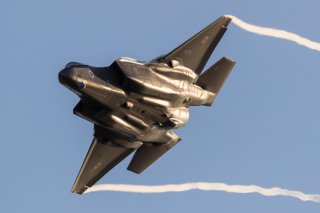Israeli F-35s Are Shooting Down Cruise Missiles—in Mid-Air
The cruise missile itself was probably launched from Yemen by Houthi rebels who have been launching missiles and drones at Israeli targets from the country since shortly after the fighting in Gaza started.
On Thursday, the Israeli Air Force announced the successful downing of an airborne cruise missile by an F-35, marking the first such intercept of this sort for the highly touted stealth fighter. The announcement, which was made via X, formerly Twitter, references the aircraft as “Adir,” which is the Israeli Air Force’s name for the Lockheed Martin fighter, which means “mighty one” in Hebrew.
“In recent days, a cruise missile launched from the southeast toward the airspace of the State of Israel was detected by the control and detection systems of the Air Force. The systems followed the trajectory of the cruise missile and launched fighter jets from the Adir formation, which successfully intercepted it,” according to the Israeli Air Force’s X post.
Thus far, there have been no further details released about the intercept beyond what can be seen in the footage. This video, which appears to have been captured via either the pilot’s helmet-mounted display or the F-35’s electro-optical targeting system, shows the cruise missile in black with visible wings on either side, as well as the heat from its propulsion system – that likely was a turbojet engine.
The cruise missile itself was probably launched from Yemen by Houthi rebels who have been launching missiles and drones at Israeli targets from the country since shortly after the fighting in Gaza started.
This profile and method of propulsion are in keeping with a land-attack cruise missile Houthi forces claim to have developed commonly known as the Quds 3 – which derives its name from Iran’s shadowy Quds Force. In the image below, you can see where the heat signature from the intercepted cruise missile (shown on top) is visible above the rear portion of the missile fuselage, rather than behind it. This corresponds with the placement of the turbojet on the Quds series of missiles. Likewise, the wing shape appears similar to the wings seen in Quds series missiles.
The Quds 1 is believed to have been sourced directly from Iran, due in part to the Houthis’ lack of technological capability and industrial capacity, but also because of its aesthetic similarities to Iran’s larger Soumar cruise missile.
The Houthi movement, which currently occupies the capital city of Yemen, maintains increasingly strong ties with Iran prompting concerns among analysts that the group is rapidly becoming a regional proxy for Tehran’s aggressive regime. This would be in keeping with earlier reports that the Hamas attack on Israel that kicked off this ongoing conflict was planned, in part, with assistance from Tehran.
The Israeli F-35, known as the F-35I, is the only nation-specific iteration of the fighter, with a number of custom modifications, including a domestically produced electronic warfare suite, designed specifically for the threat environment of the Middle East and with a particular emphasis on Iran. Israel’s F-35s were the first F-35s to see combat operations, starting in early 2018.
Alex Hollings is a writer, dad, and Marine veteran.
This article was first published by Sandboxx News.
Image: Andreas Zeitler / Shutterstock.com

